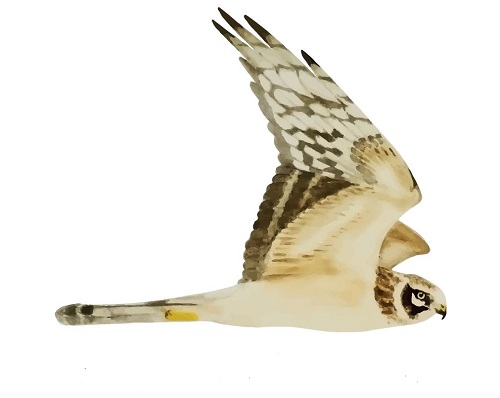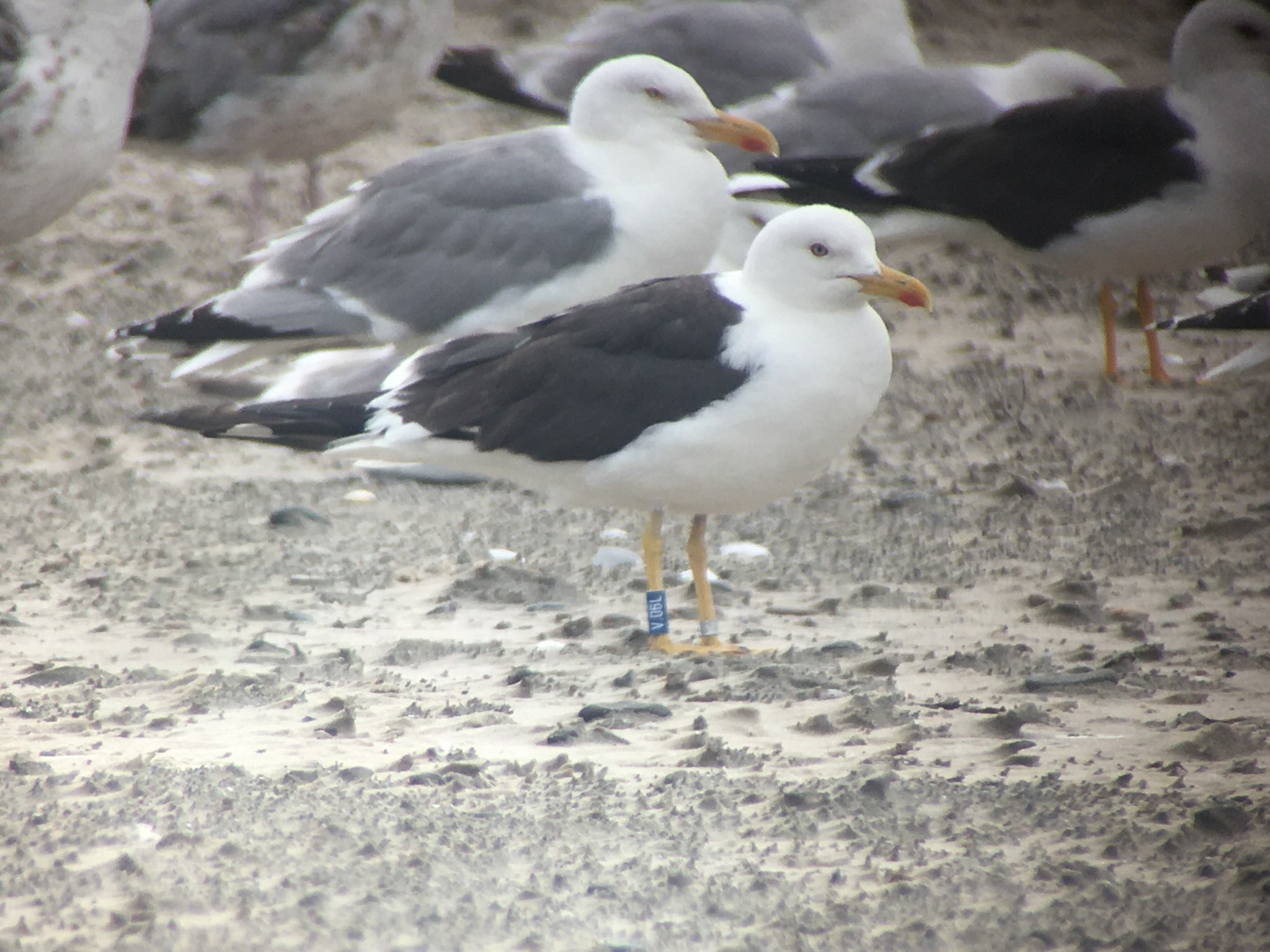Her på Skagen Fuglestations blog bringes korte nyheder i dagbogsformat om hændelser på fuglestationen.
Se indlæg fra måned: feb. (11)mar. (31)apr. (30)maj (31)juni (30)juli (31)aug. (31)sept. (30)okt. (31)nov. (30)dec. (6)
Snake Bird and Mist Nets
Early this morning while Nathan and I were doing our daily migration counts, we received an exciting message from the ringing team up at KAB. The team composed of Martina, Max, and Alice had caught something extra special in their mist nets, a wryneck (Vendehals), a first for many of us. The wryneck is part of the woodpecker family and is capable of doing extraordinarily strange movements with its neck. It is said that the movements the bird exhibits are a threat display to scare away predators. In fact, they can turn their head nearly 180 degrees and the snake-like movement has given them the nickname of ‘’snake bird’’ in parts of the world.
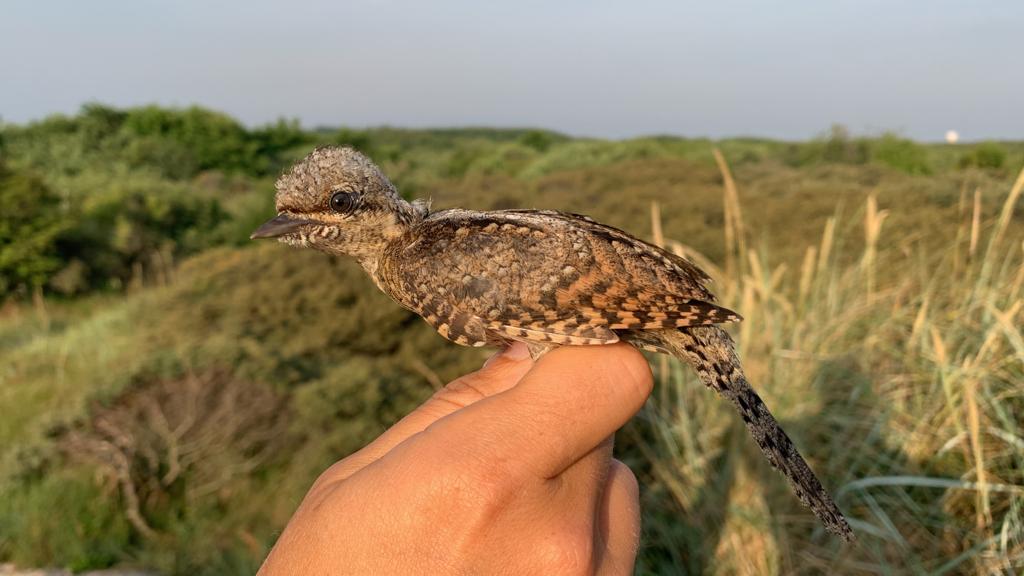
Wryneck (Vendehals), Photo Credit: Max Laubstein
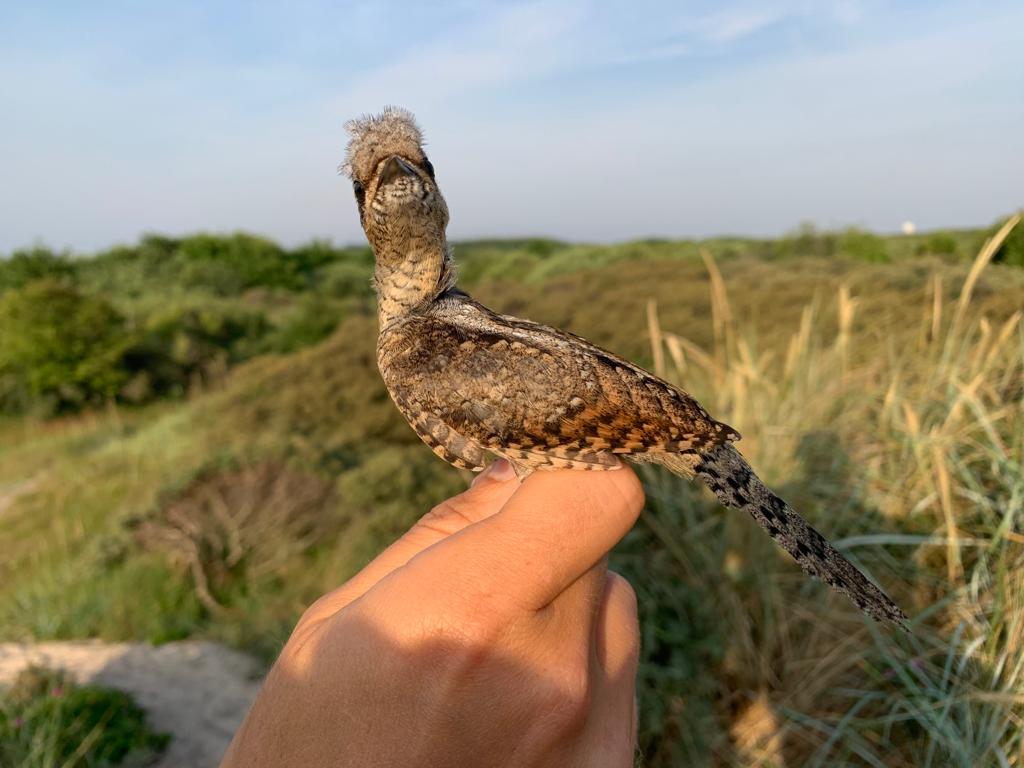
Wryneck (Vendehals), Photo Credit: Max Laubstein
While Nathan rushed to catch a glimpse of the bird and take the necessary photographs after it had been rung, I caught three Common Kestrels (Tårnfalk) in my scope down by the beach. Much to my delight, the juvenile was practicing its flying abilities in the dunes and I was briefly able to watch it hone its skills. Over the course of the morning, over 20 individuals of the species were recorded in the area, perched on trees, flying above, and practicing the skills necessary to become an efficient predator.
In the early afternoon, Knud was kind enough to drive our team to the cormorant lake to begin the arduous but necessary task of creating new mist net lanes. Although it will take many days to complete the task and the location seems to be yet another favorite for mosquitoes, many bird species were heard over the course of the activity further confirming the potential of the location for future bird ringing. The location's proximity to a lake combined with a terrain compromising of dunes and reeds is prime habitat for many passerine species, it is, therefore, our hope that new nets at the location will enable us to continue the important work conducted by the Skagen Fuglestation in the form of ringing and data collection.
Local observations of the day in DOFBasen
Ringing at Kabeltrommlen:
Vendehals (Wryneck): 1
Gråsisken (Redpoll): 1
Rørsanger (Reed Warbler): 3
Gærdesmutte (Wren): 1
Gærdesanger (Lesser Whitethroat): 3
Kærsanger (Marsh Warbler): 2
Tornsanger (Common Whitethroat): 17
Dompap, lille (Bullfinch): 1
Sivsanger (Sedge Warbler): 1
Løvsanger (Willow Warbler): 4
Sortmejse (Coal Tit): 2
Havesanger (Garden Warbler): 1
Munk (Blackcap): 2
Blåmejse (Blue Tit): 4
Rørspurv (Reed Bunting): 1
Gransanger (Chiffchaff): 6
total: 50
People: Rita DeLucco, Alice Scalzo, Nathan Delmas, Max Laubstein, Martina Hillbrand, Knud Pedersen
Mosuitos and birds
As ancient ringer’s wisdom says: where there are mosquitos, there are birds. We had a lot of mosquitos today probably due to the changed weather conditions and we had quite a few birds too in the ringing. Since Alice, Nathan and Rita took today off in order to explore a natural area (Lille Vildmoos) further south, it was only me and Max at the ringing today. Luckily, we were helped out by former volunteer Frederik who is staying in Skagen on vacation at the moment with family. We had a couple net checks where we were quite happy to have his help! Like other days, today has been quite windy, however, over night the winds have turned from west to south which made everything just a little different.
We were not overwhelmed with birds nor were there any other species than what we are used to by now, save the robin (rødhals) which appeared in the nets to remind us that winter is not that far away.
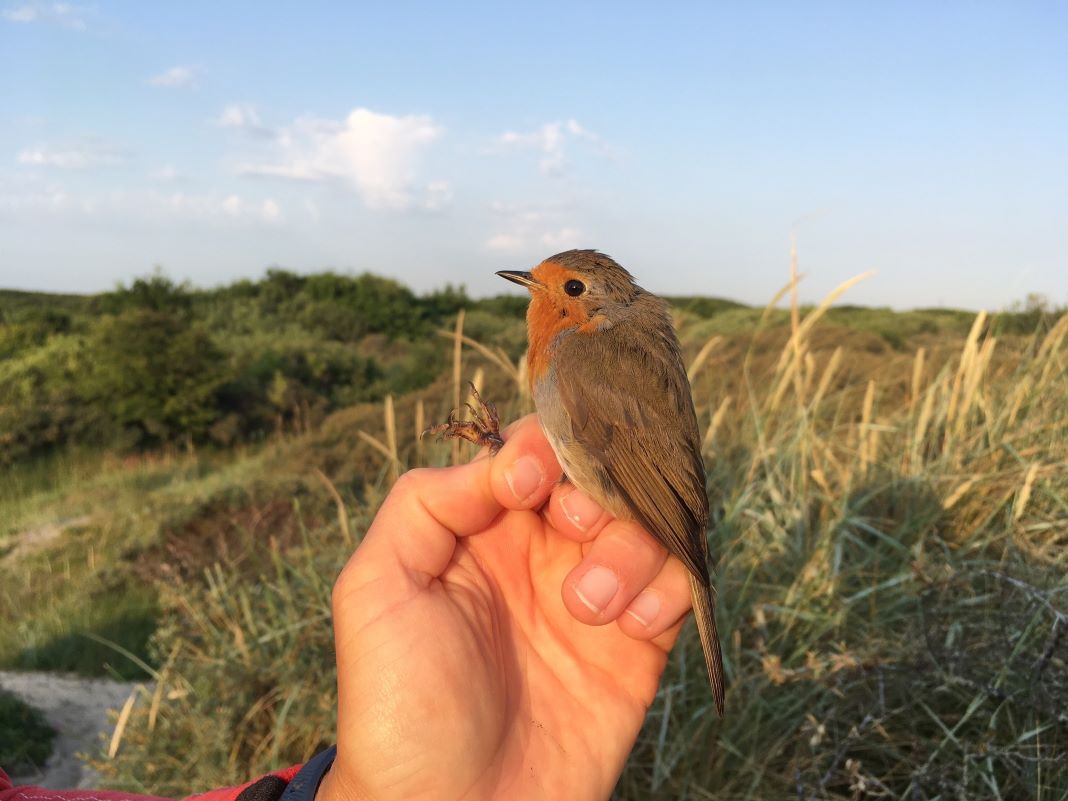
We also had a juvenile bearded reedling (skægmejse) which was quite a treat, another one calling from the reeds. All of them are probably local birds, though. Migration is still very slow but the fact that we catch a lot of common whitethroats (tornsanger) and very few of them are ringed now also means that we can get a rather good impression of how big the population really has to be. And I am glad to announce that it is big. Of course, there are big variations between years but this year seems to be rather good for common whitethroat, as other years have been particularly good for blackcaps (munk). And Whitethroats are pretty, like this adult male shows:
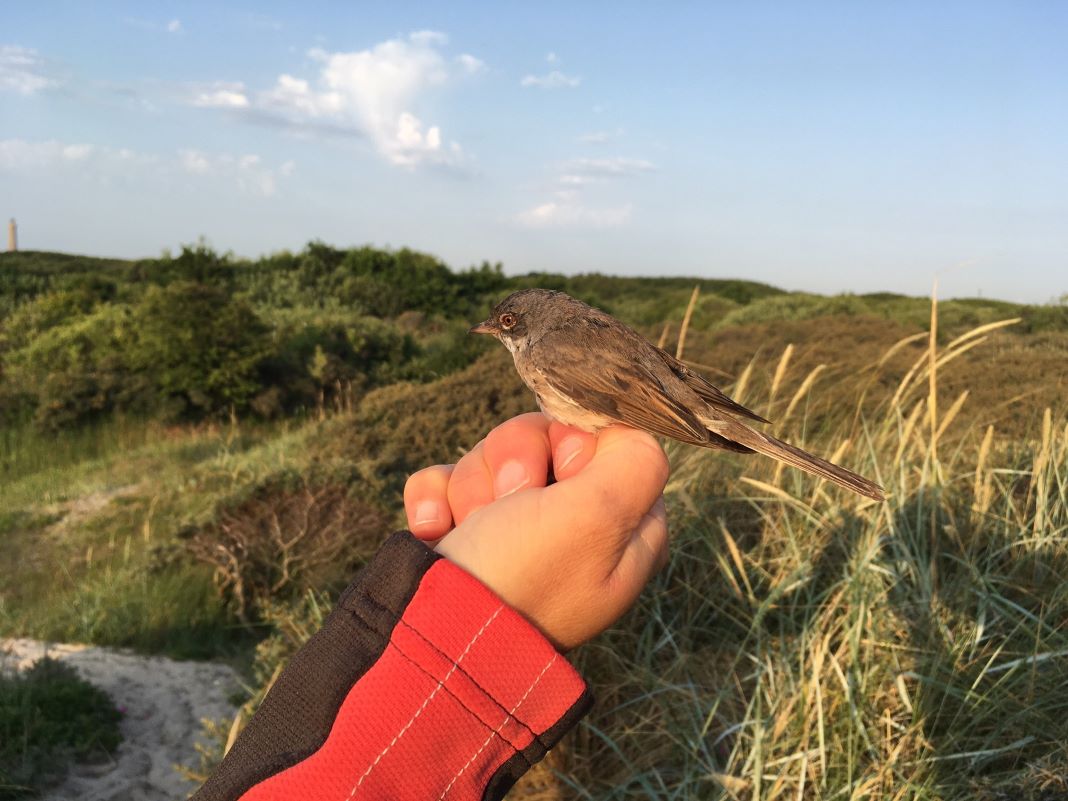
Apart from birds it was a very nice morning in nice weather out at Kabeltromlen, hanging out with nice people, catching up with old friends and eating ‘rundstykker’, that a visitor kindly brought to introduce us to traditional Danish breakfast.
The rest of the crew had a fantastic day at the Lille Vildmoos and they managed to see moose which was one of their goals:

Local observations of the day in DOFBasen
Ringing at Kabeltromlen:
Solsort (Blackbird) 2
Rødhals (Robin) 1
Løvsanger (Willow Warbler) 2
Gransanger (Chiffchaff) 6
Rørsanger (Reed Warbler) 3
Kærsanger (Marsh Warbler) 2
Gulbug (Icterine Warbler) 1
Gærdesanger (Lesser Whitethroat) 1
Tornsanger (Common Whitethroat) 16
Munk (Blackcap) 6
Musvit (Great Tit) 2
Skægmejse (Bearded Reedling) 1
Rørspurv (Reed Bunting) 1
Total: 44
People: Rita DeLucco, Alice Scalzo, Nathan Delmas, Max Laubstein, Martina Hillbrand, Frederik Johansen, and our guests Iben and Olivia.
A sunny day in Skagen
Hello everyone !
Today was a great day for birding and for us; we divided in 2 teams so we could both ring in Grenen and count the migrating birds at the beach. Max and Alice went sea watching and they spotted a red phalarope resting on the sand.
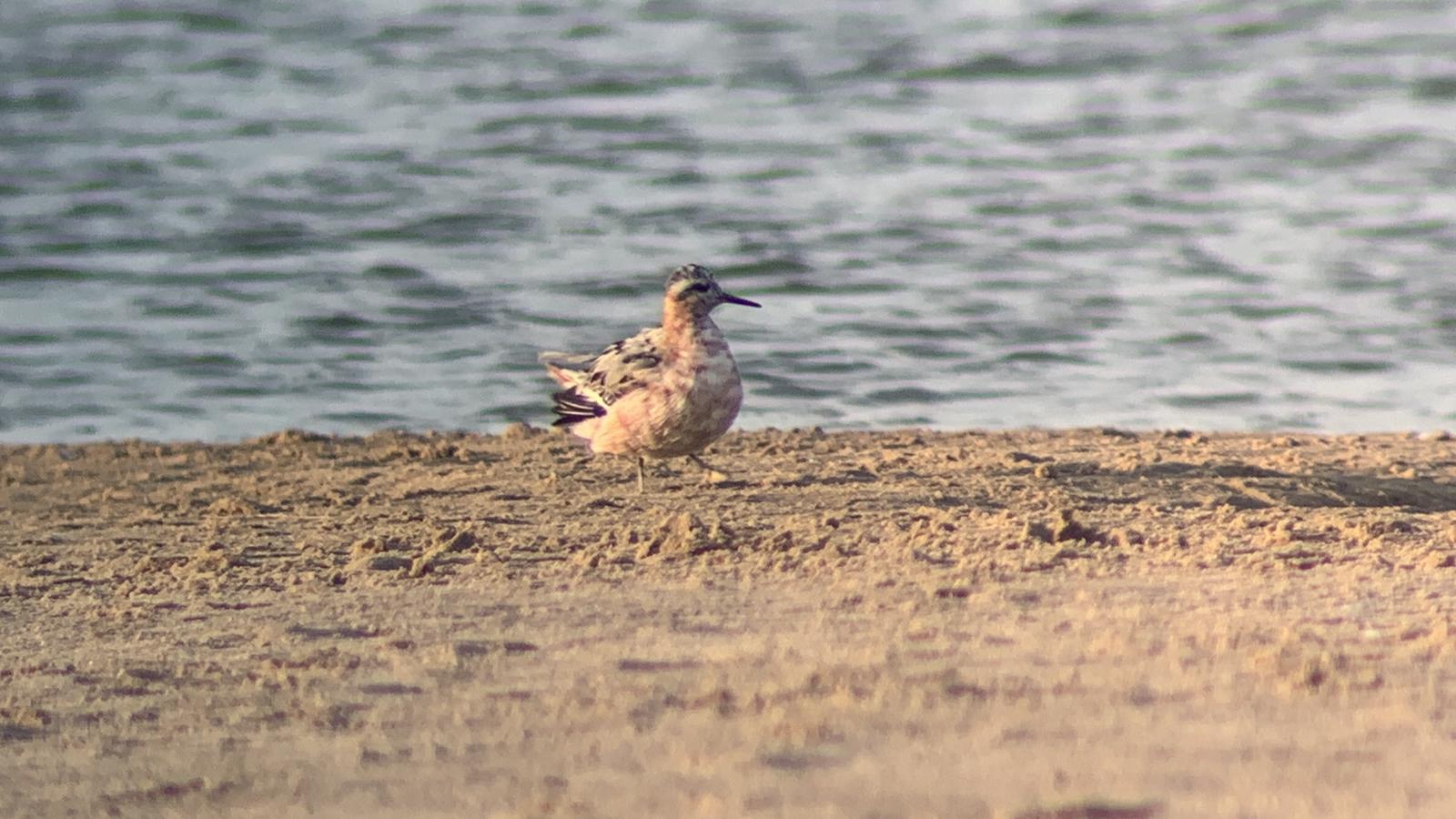
Red phalarope (Thorshane) by Max Laubstein
Martina, Rita and I ringed a decent amount of birds; a few willow warblers (løvsangers) among them. It is a sign of the beginning of the migration !
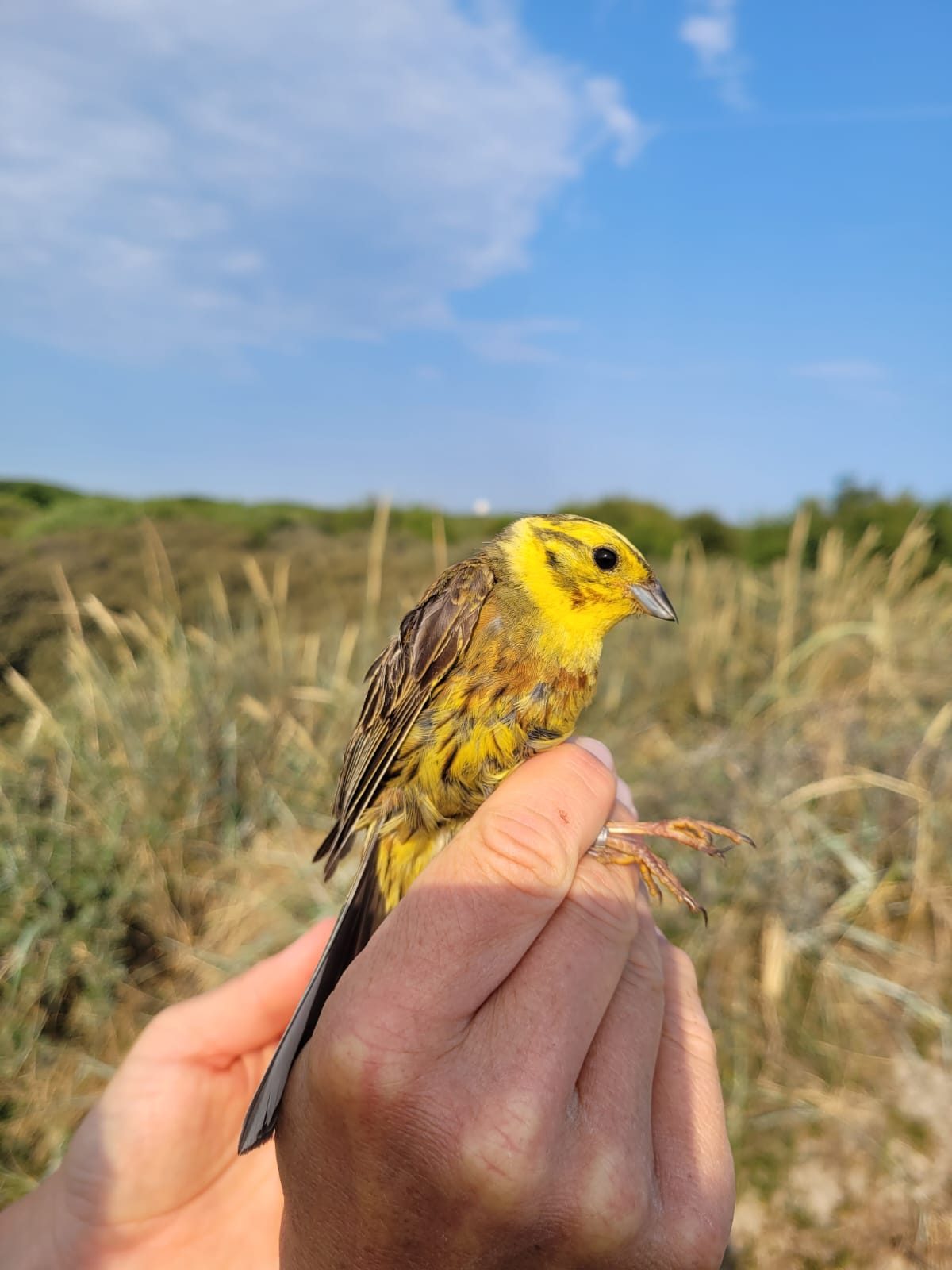
A yellow hammer (Gulspurv) after being ringed by Nathan Delmas
Later in the day, Alice went out to look at butterflies and found some rare Phengaris alcon !
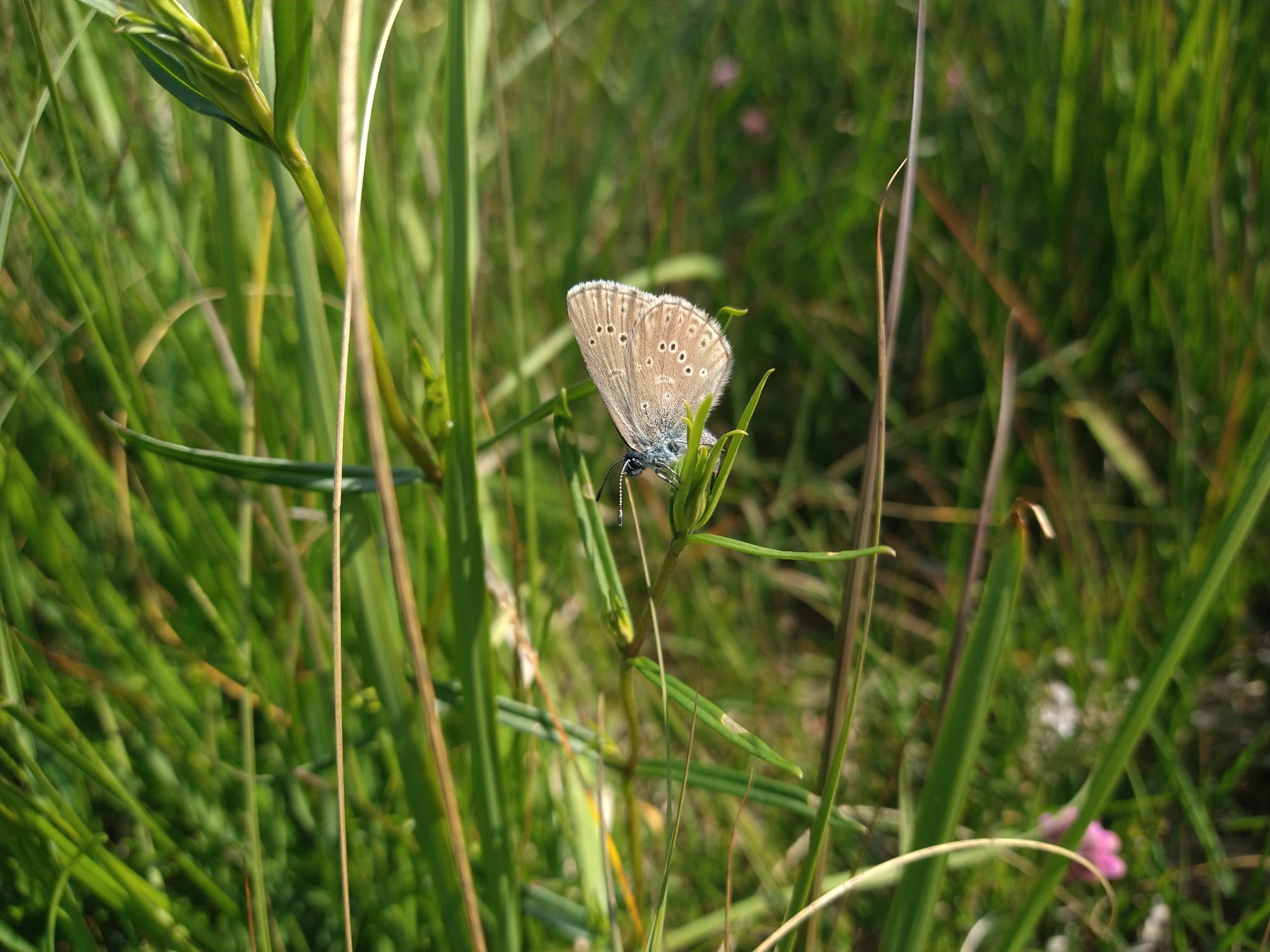
Phengaris alcon by Alice Scalzo
Meanwhile, Martina observed a little Auk in the harbor quite close from the shore.
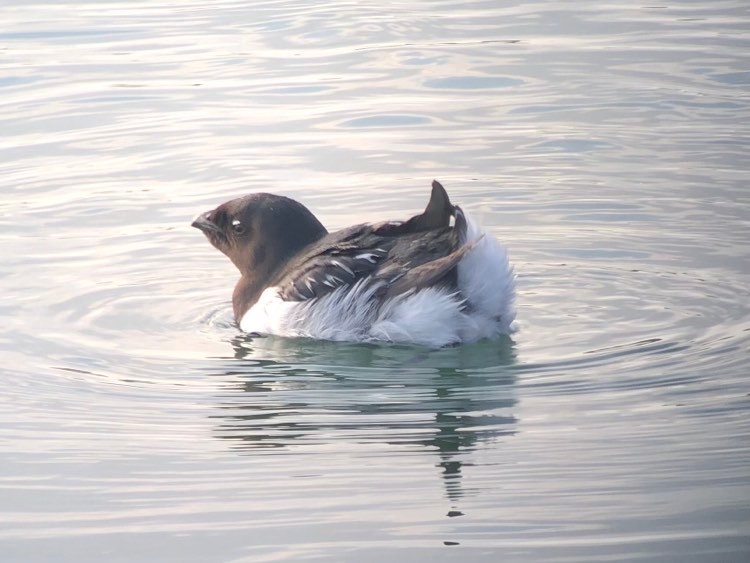
A swimming little auk (Søkonge) by Laila Neermann
Our day ended with a nice chile cooked by Max !
I hope everyone had a day as nice as ours and see you tomorrow !
Nathan
Marsh Warbler 1
Reed Warbler 1
Blackcap 2
Lesser Whitethroat 2
Common Whitethroat 17
Willow Warbler 5
Chiffchaff 1
Chaffinch 1
Redpoll 1
Yellowhammer 1
Total: 32
People: Rita DeLucco, Alice Scalzo, Nathan Delmas, Max Laubstein, Martina Hillbrand, and our guests Iben and Olivia.
Gulls & a Birthday
Hi all!
Our original plans for today were for Martina, Rita, and Nathan to go ringing at Kabeltromlen, and for myself and Alice to do a seawatch at the tip of Grenen. Early this morning however, Martina awoke to find rain on the forecast, so ringing had to be cancelled. Nonetheless, Martina joined me to conduct the seawatch at 4:45. Compared to the past few days, it was fairly slow. Foggy conditons overnight likely inhibited most nocturnal migrations, so migratory waders / shorebirds were essentially absent, save for a single Dunlin (Almindelig Ryle), looking stunning in breeding or alternate plumage high up on the beach. In the first hour of the seawatch, I was able to spot a handful of Northern Fulmars (Mallemuk) distantly arcing over the horizon, simply silhouettes in the intense amber glow of the sunrise.
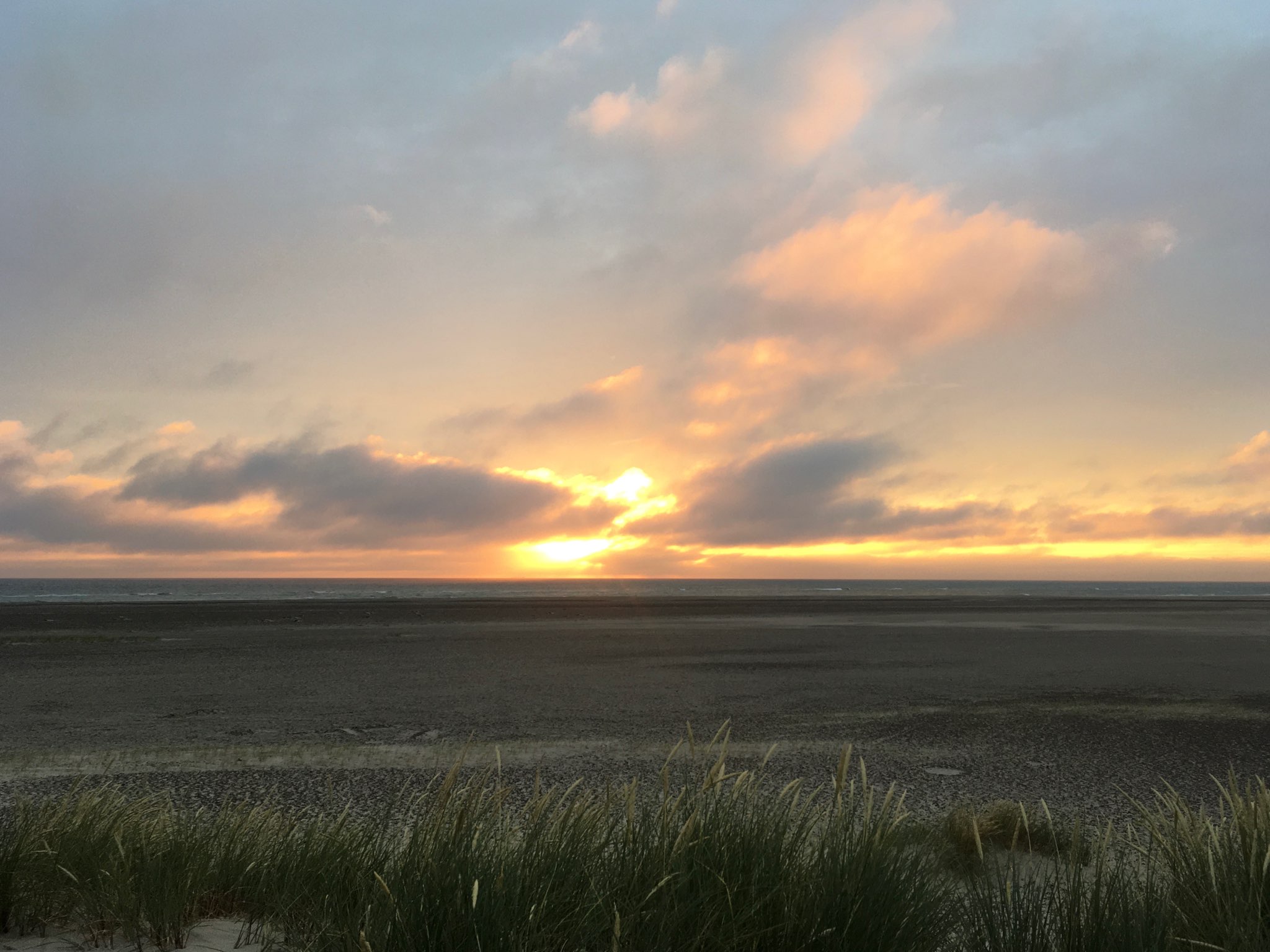
A beautiful sunrise from Grenen
Northern Gannet (Sule) numbers were also fairly high, I tallied at least 160 at most, our highest count from the past few days. Though the offshore realm wasn't at its most active, after the seawatch I spent an hour combing through the mixed gull flocks on the beaches at Grenen searching for color-ringed gulls. Ultimately, I was able to succesfully read the codes on 6 birds' (2 Great black-backed gulls (Svartbag) and 4 Lesser black-backed gulls (Sildemåge) ) color rings. We will have to wait a bit until we receive the data from the lessers' rings, but we were able to learn that while one of the great black-backs has remained around northern Denmark its whole life (as far as we can tell), the other was originally ringed in Norway, and has journeyed at least as far as the Netherlands in the past few years!
One of the color-ringed lesser black-backed gulls (Sildemåge) observed today.
While Martina and I seawatched, the others slept in to 6 am or so (that's sleeping in for our standards), and did some work repairing torn mist nets, among other things. In the afternoon, Simon lead a ringing tour for a large group of tourists in the lighthouse garden. One Greater Whitethroat (Tornsanger) was caught, and hopefully provided an excellent opportunity to demonstrate to the public the importance of the ringing we conduct here at Skagen Fuglestation. Soon after the tour, Simon for left for his road trip to Norway: we wish him a wonderful adventure!
The highlight of today was unequivocally celebrating the birthday of Alice, who has been here at Skagen Fuglestation since March! Before he left, Simon lead us in a Danish birthday song to celebrate Alice. I can't say the rest of us understood the words we were singing, but it was fun nonetheless! In the evening, we went to beach for a while, where we played a fun bowling-like game (shamefully, Martina & Rita absolutely obliterated Alice, Nathan, and I's team), and enjoyed a dinner picnic. Nathan went for a quick swim in the Kattegat, but apparently the water was underwhelmingly not cold. And, as always, we paid attention to the feathered beasts that surround us, and got to see a juvenile Black Guillemot (Tejst) floating offshore.
Again, we wish Alice the happiest of birthdays, and are so happy to work with her here at Skagen!
Cheers!
Max
Local Observations of the Day in DOFBasen
People: Rita DeLucco, Alice Scalzo, Nathan Delmas, Max Laubstein, Martina Hillbrand, and our guests Iben and Olivia.
Birds and cookies
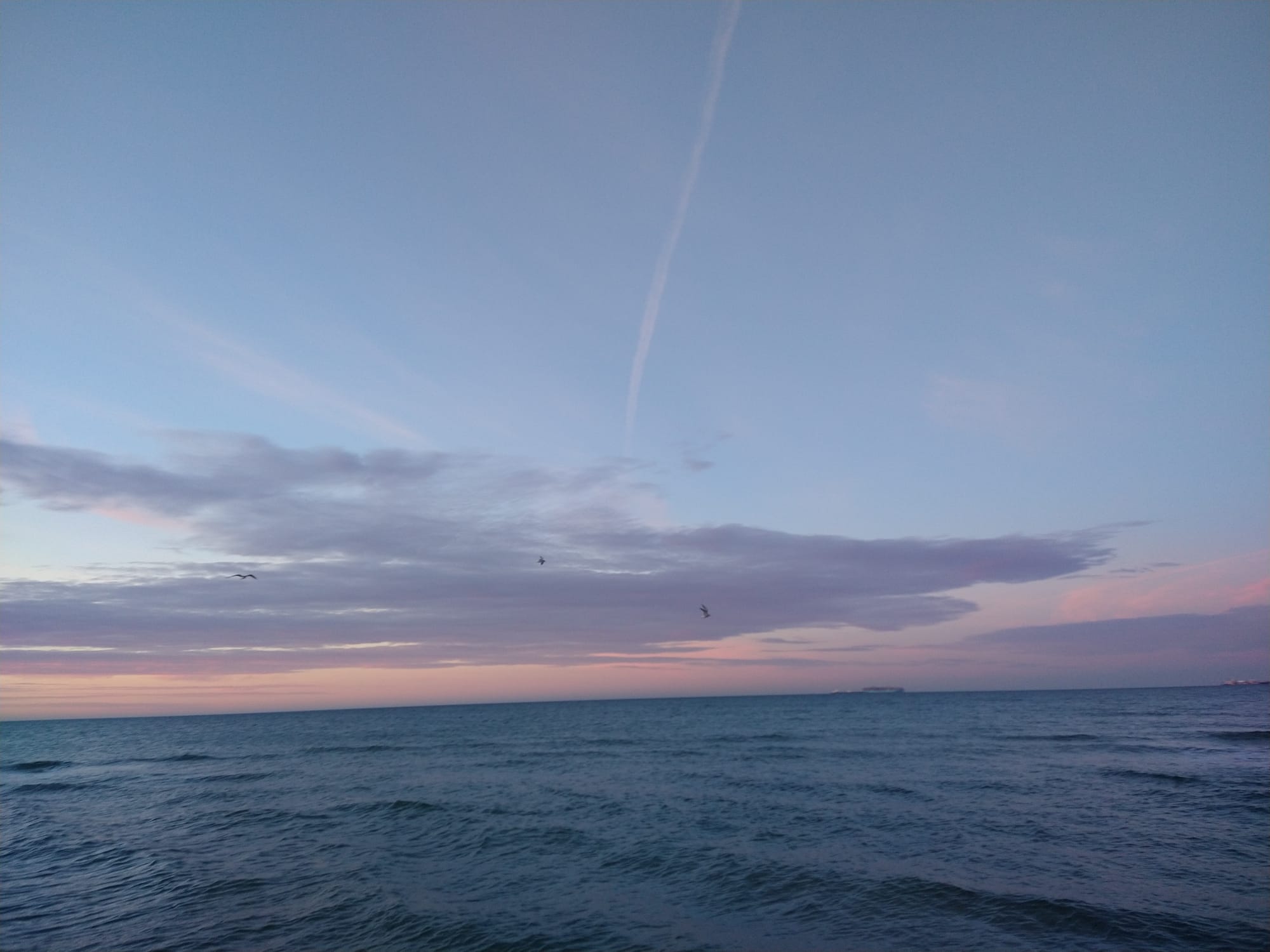 Nonetheless we were out there, at the tip, counting birds. We had a few different species, Whimbrels (Småspove), Golden Plovers (Hjejle), and Simon heard a Temminck's Stint (Temmincksryle). Martina managed to read new colour rings afterwards.
Nonetheless we were out there, at the tip, counting birds. We had a few different species, Whimbrels (Småspove), Golden Plovers (Hjejle), and Simon heard a Temminck's Stint (Temmincksryle). Martina managed to read new colour rings afterwards. Max and I also installed a new net in KAB, let's hope we can try it out tomorrow if the weather allows.
Max and I also installed a new net in KAB, let's hope we can try it out tomorrow if the weather allows.People: Rita DeLucco, Alice Scalzo, Nathan Delmas, Max Laubstein, Simon S. Christiansen, Martina Hillbrand, and our guests Iben and Olivia.
The Mysteries of Migration
On the beach in the early morning bird watchers and tourists can be seen with the naked eye, followed by the different species of gulls (Sølvmågeand) and terns (Terner) that dominate the landscape. It is only upon careful observation using the scopes and binoculars at our disposal, that the smallest birds come into view near the pools of water on the beach. The smallest of them are the ringed plover chicks (Stor præstekrave), who blend into the landscape by resembling one of the many pebbles on the beach and walking at a strange pace so as not gather attention from predators lurking above. Over the past couple weeks, our team has been able to ring a couple of the chicks, but just when we thought we found the rest of the chicks, they would disappear before our eyes by blending in with the pebbles. If their clever plumage was not enough to deter predators and lead ringers astray, the ringed plover parents attempt to divert your gaze and lead you away by pretending to be injured. But Martina was quick, gentle, prepared, and ready to ring them late in the morning and they will undoubtedly provide meaningful data.
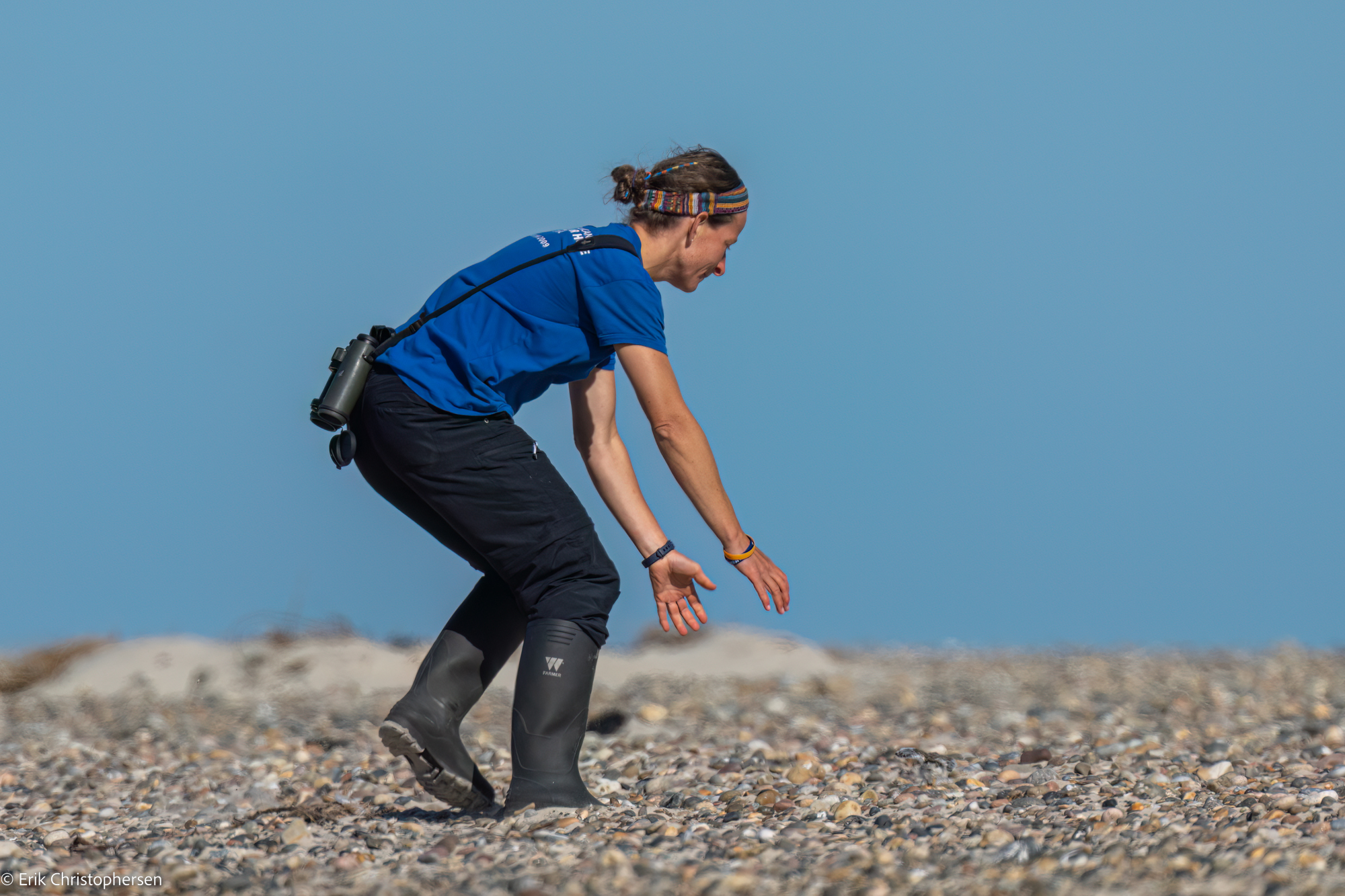
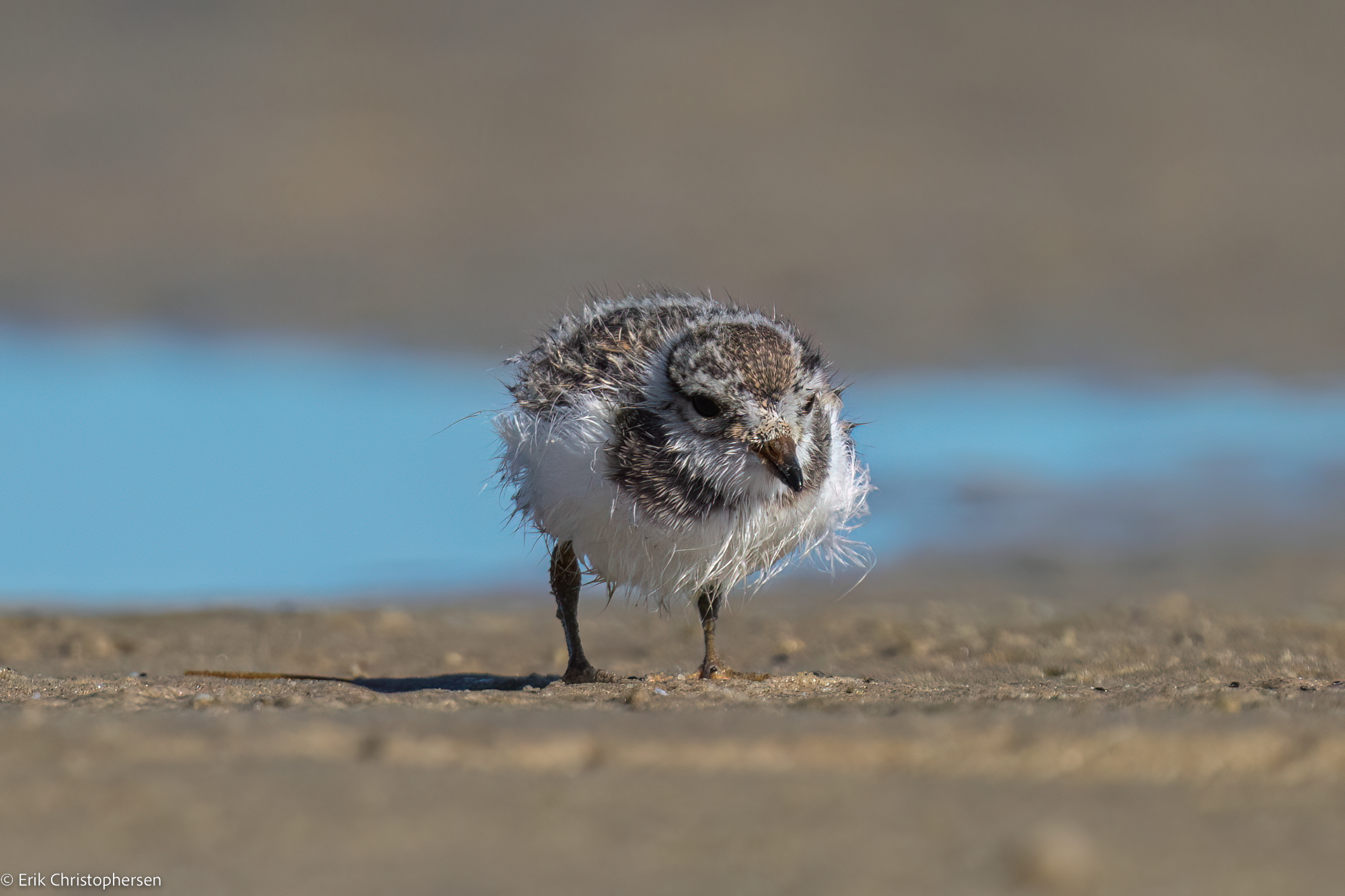
In the afternoon, our guest Mark Desholm was kind enough to give an interesting presentation on bird migration as well as the use of radar and thermal technologies in ornithological research. The topic interested all of us, and even prompted Hanelie, a former volunteer, to ask if she could join in virtually. Although some of the presentation was familiar to many of us, a lot of the information encouraged discussion about the different uses of technology and how the data they collect can positively impact the understanding of migration, environmental policy, and the construction of wind farms. The topics also opened our eyes to the gaps in our knowledge relating to how birds migrate and why they appear to occasionally migrate in ways that appear “wrong” to researchers, further plunging bird migration into mystery. But Mark’s presentation strongly emphasized the potential for new research and the new frontiers of understanding bird migration. As thanks to new emerging technologies as well as scientists constantly questioning what we believe are the abilities of certain species and understanding what evolution has so brilliantly designed, the world of migration is still very much open for exploration.
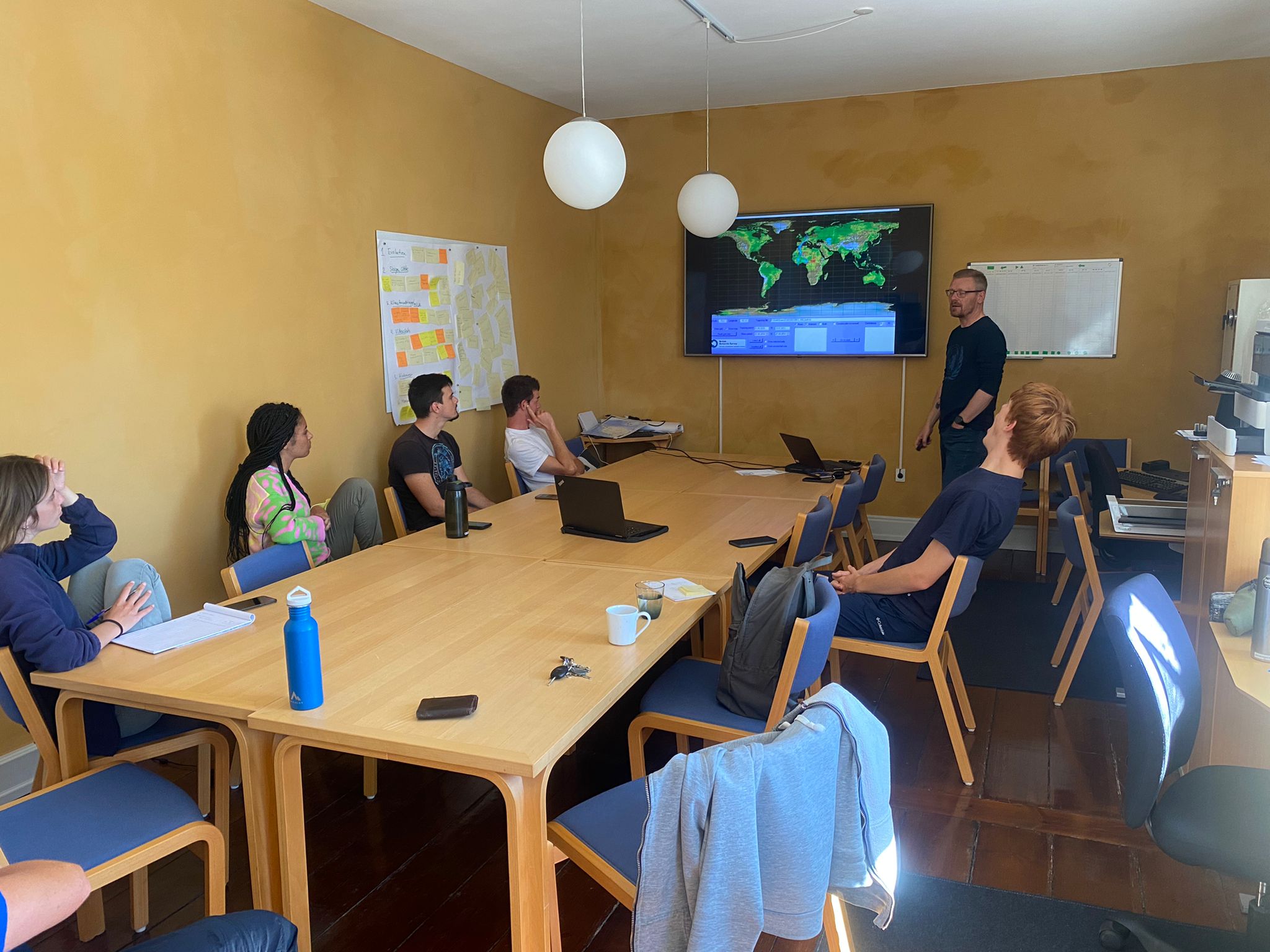
Local observations of the day in DOFBasen
People at the Station: Rita DeLucco, Alice Scalzo, Nathan Delmas, Max Laubstein, Simon S. Christiansen, Martina Hillbrand, Knud Pedersen, and our guests Mark and Malthe Desholm
Birds everywhere
Today we finally went ringing again after two days of not being able to go because of weather conditions. It was a very calm day regarding the weather and in the first few hours we had more birds than what we were used to in the past week or two. Migration has not really started yet for most birds, however, we are catching more and more juvenile birds which either have hatched in the area (true mostly for common whitethroats, tornsanger and chiffchaff, gransanger) or close by and which are now exploring the wider surroundings of their birth place (e.g. blue and great tits; blåmejse og musvit; or blackcaps, munk). Talking about blackcaps, we caught our first juvenile today and we are waiting for more.
Of course, all the juvenile whitethroats we get (and quite a few are recaptures so they don't even show up in the ringing totals below) provide a lot of valuable data, for example on how long they stay in the area before they leave and if we are lucky also, whether they come back next year. But they do get a little boring after a while, so we were extremely pleased to find a very special bird in one of the nets this morning: a green sandpiper (svaleklire).
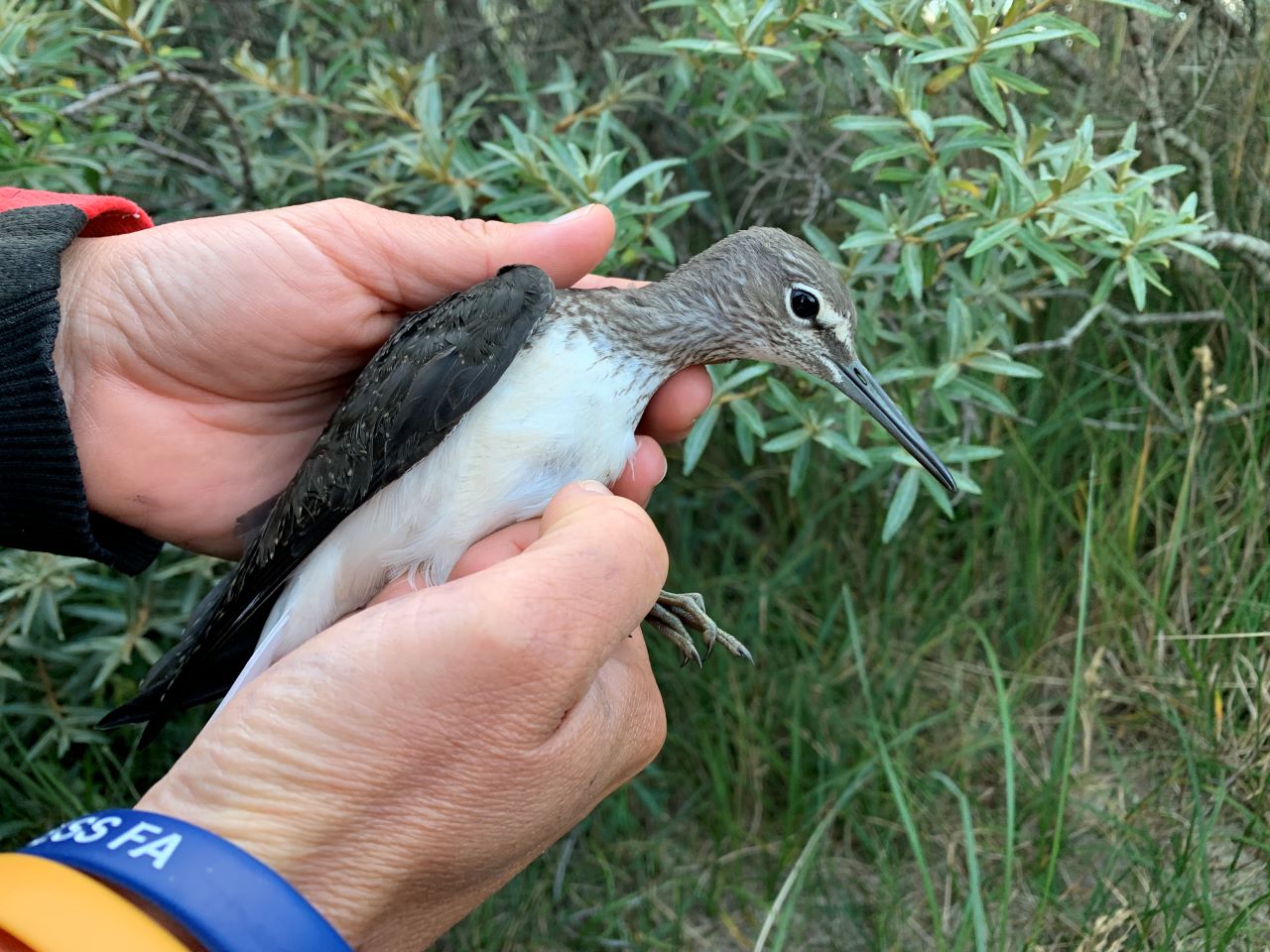 It was a juvenile that must be making its first southwards migration since they do not breed in the area. The birds that we get here breed mainly in Sweden and Norway and they start their migration a little earlier than songbirds do. I assume this is mother nature’s way of making sure that bird watchers always have something to get excited about, no matter what time of the year.
It was a juvenile that must be making its first southwards migration since they do not breed in the area. The birds that we get here breed mainly in Sweden and Norway and they start their migration a little earlier than songbirds do. I assume this is mother nature’s way of making sure that bird watchers always have something to get excited about, no matter what time of the year.
While the rest of us was at the ringing, Nathan and Rita went with Knud (who gets credits for the photos below) to World’s End 3 to do some seawatching. They also had a large variety of birds including a puffin (lunde), a dozen bar-tailed godwits (lille kobbersnebbe), a ruddy turnstone (stenvender) and a lot of common terns (fjordterne). They also managed to read a color-ringed kittiwake (the same we read last weekend) and a sandwich tern (splitterne).
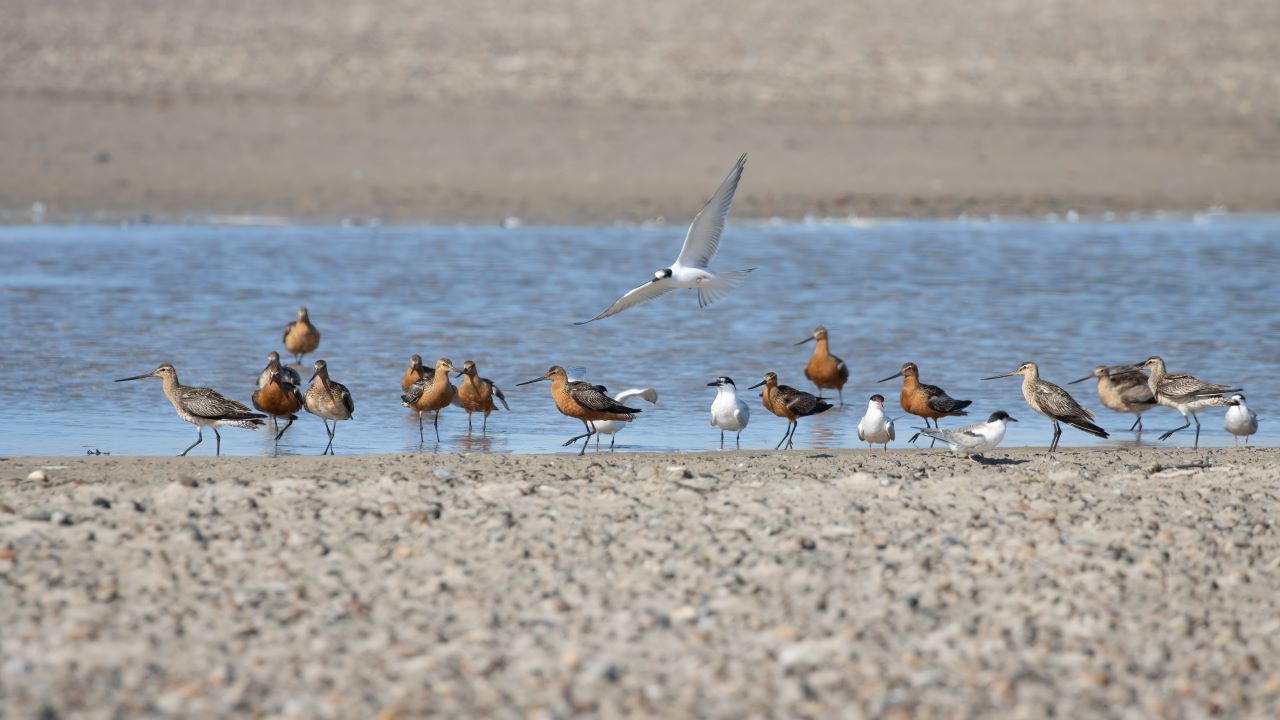
On the down side, they had to deal with visitors who left their dog roam freely among the roosting birds which is forbidden on Grenen Beach between April and October for the protection of the birds. Seeing that the chicks of the common ringed plovers (stor præstekrave) are not able to fly yet, they may have just escaped their death because of Nathan’s and Rita’s interference. So, if you want to take your dog to the beach, please keep it on a leash so that the birds can breed and rest in peace on the beach!
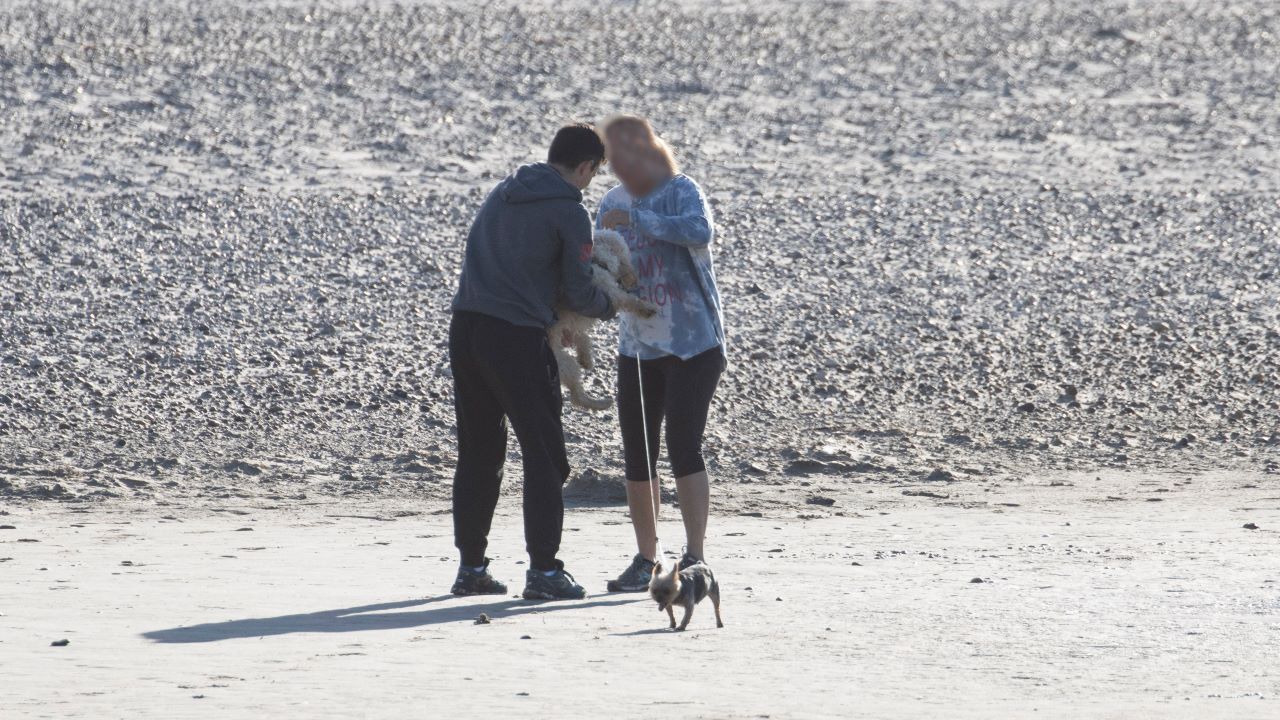
While we were out in the morning, Lærke left but not before making sure she had our contact details to send us the video she is making about the ringing, once it is finished. We are very excited to see it and hope Lærke will get into the university program she applied to so she will be close to Skagen and can visit more often! Mark and Malthe are staying until Sunday, which is good, since Mark is trying to get our fancy bat detector up and running for migration season.
In the afternoon we had a session with Simon where we talked about moult and aging birds. Then we spent the rest of the afternoon and evening making sure all the data is up to date. And we ate a nice dinner in order to load our batteries for the migration season to come!
Birds ringed at Kabeltrommeln:
Green sandpiper (svaleklire) 1
Song thrush (sangdrossel) 1
Blackbird (solsort) 1
Lesser Whitehtroat (gærdesanger) 2
Common Whitethroat (tornsanger) 21
Blackcap (munk) 2
Icterine warbler (gulbug) 1
Chiffchaff (gransanger) 5
Great tit (musvit) 2
Blue tit (blåmejse) 1
Reed bunting (rørspruv) 1
Total: 38
Local observations of the day in DOFBasen
People at the station: People at the Station: Rita DeLucco, Alice Scalzo, Nathan Delmas, Max Laubstein, Simon S. Christiansen, Martina Hillbrand, Knud Pedersen, and our guests Mark, Malthe and Lærke Desholm
A windy day among the birds
Hello everyone !
Our day starts with the sunrise; Martina, Rita and I walked along the water from the lighthouse to the tip of the beach. We counted the birds that were roosting on the sand and tried to observe migrating birds. Unfortunatly, it was a very windy morning and not a lot of birds were seen but Martina managed to get very close to some gulls and take a good picture of 3 ringed birds.
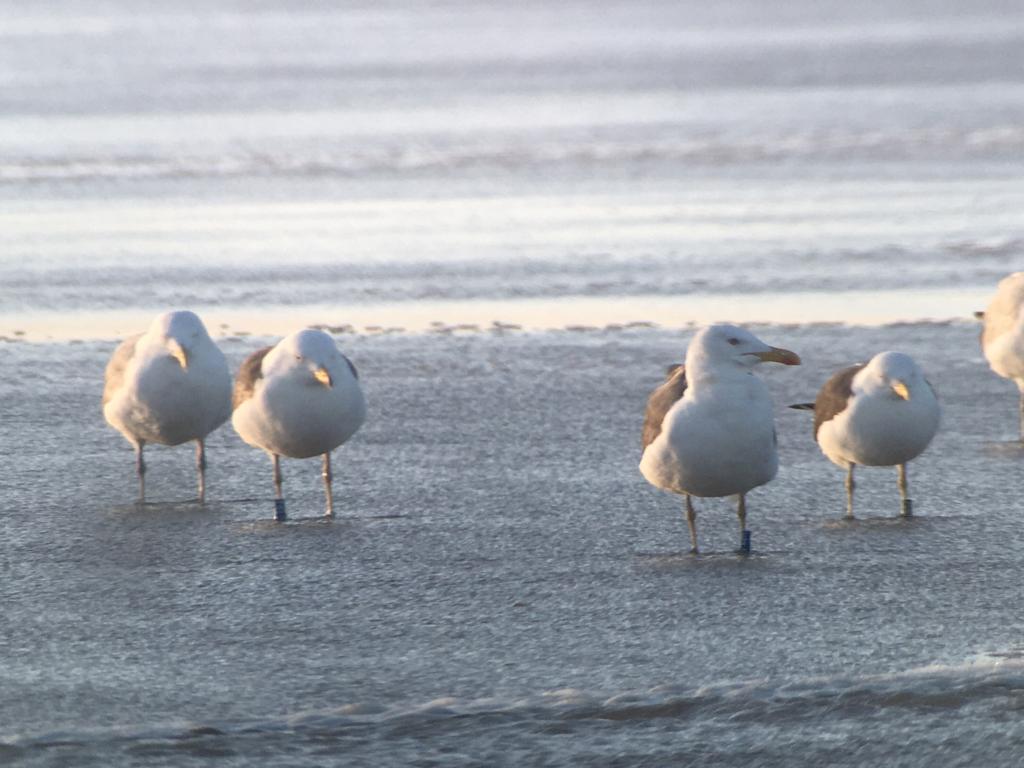
3 ringed lesser black-backed gulls in the middle of the roost
One of the bird has been ringed near Oslo in 2017, spotted in Germany and Spain in 2018 and now it is stopping by Skagen. The other one was ringed in Hirsholm in 2017, was spotted in France in 2018, in Denmark in 2020 and then in Morocco in 2021 before coming back to Denmark this year !
A bit later in the morning, Knud and Max joined us to count the migrating birds. Once again, not a lot of birds were observed.
In the afternoon, Martina and I went shopping and observing birds in the harbor while Max tried to catch some white wagtails in the garden.After a very hard biking experience due to the wind, we counted more than 200 cormorans resting on the pier with few gulls among them.
Tonight the guests cooked for us and we are ready to enjoy a delicious meal !
Have a great evening and see you tomorrow !
Nathan
Local observations of the day in DOFBasen
People at the Station: Rita DeLucco, Alice Scalzo, Nathan Delmas, Max Laubstein, Simon S. Christiansen, Martina Hillbrand, Knud Pedersen, and our guests Mark, Malthe and Lærke Desholm
Gulls' Night Out
 Hi all!
Hi all!
The events of today's blog actually begin in the late hours of last night, when we drove to Jerup ~30 km south of Skagen, to attempt night-catching some nocturnal species in a field. Unfortunately, after several hours of waiting for something to end up in one of our nets/traps, we had not succeeded. Thankfully, in anticipation of a strikeout, we had brought the nets and lights necessary to attempt night-catching of shorebirds/waders at the nearby Jerup Strand. Conditions weren't ideal, and we are still quite early for shorebird migration to be in full swing. While night-catching, we use the Fuglestation's quite-fancy thermal monocular to spot birds roosting on the beach/mudflats in the darkness, approach them with a bright flashlight, before swiftly netting them. But, at these high latitudes, while the sun sets, it doesn't set very "deep," per se. At its deepest, the sun's light still creeps over the horizon, so we experience a sort of perennial twilight through the night. This confounds our ability to efficiently sneak up on the birds out of total darkness. As Lisa and I (we were the only ones with proper waterproof footwear) roamed the mudflats, we encountered a few fairly-large groups of Dunlin "Almindelig Ryle," but they all flew off before we could get close enough to attempt a catch. Nevertheless, we persisted, and ultimately suceeded in catching a young black-headed gull "Hættemåge" and two young common ringed plovers "Stor Præstekrave." Rita, Nathan, and I each ringed one of the birds, with the assistance of Lisa and Simon, providing our first experience using steel rings, which are used for most waterbirds, as opposed to the aluminium rings we ring most terrestrial species with. Steel rings can be quite difficult to close properly, as they are less malleable and need to "click" shut properly.
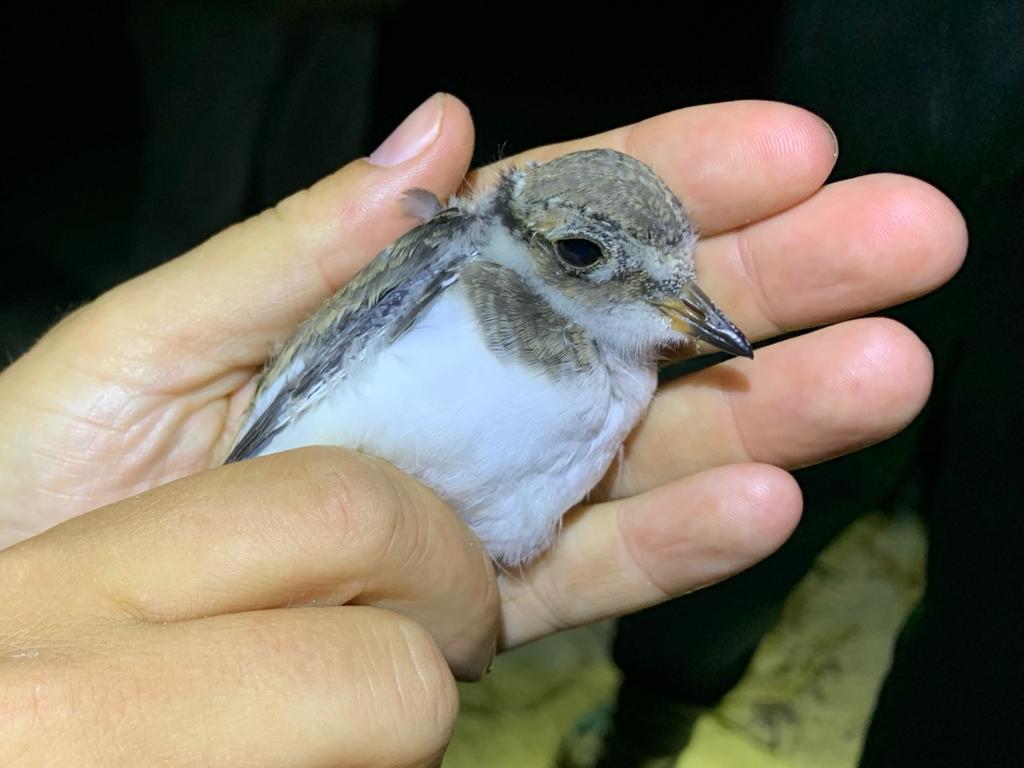
Ringed Plover Chick
Those of us who spent last night night-catching spent much of this morning sleeping in. Conditons were far too windy for any ringing to happen today, so we completed some data entry, checking, and other tasks around the station. In the afternoon, Martina, Rita, and Nathan went to "Cormorant Lake" to survey the cormorant "Skarv" breeding colony there.
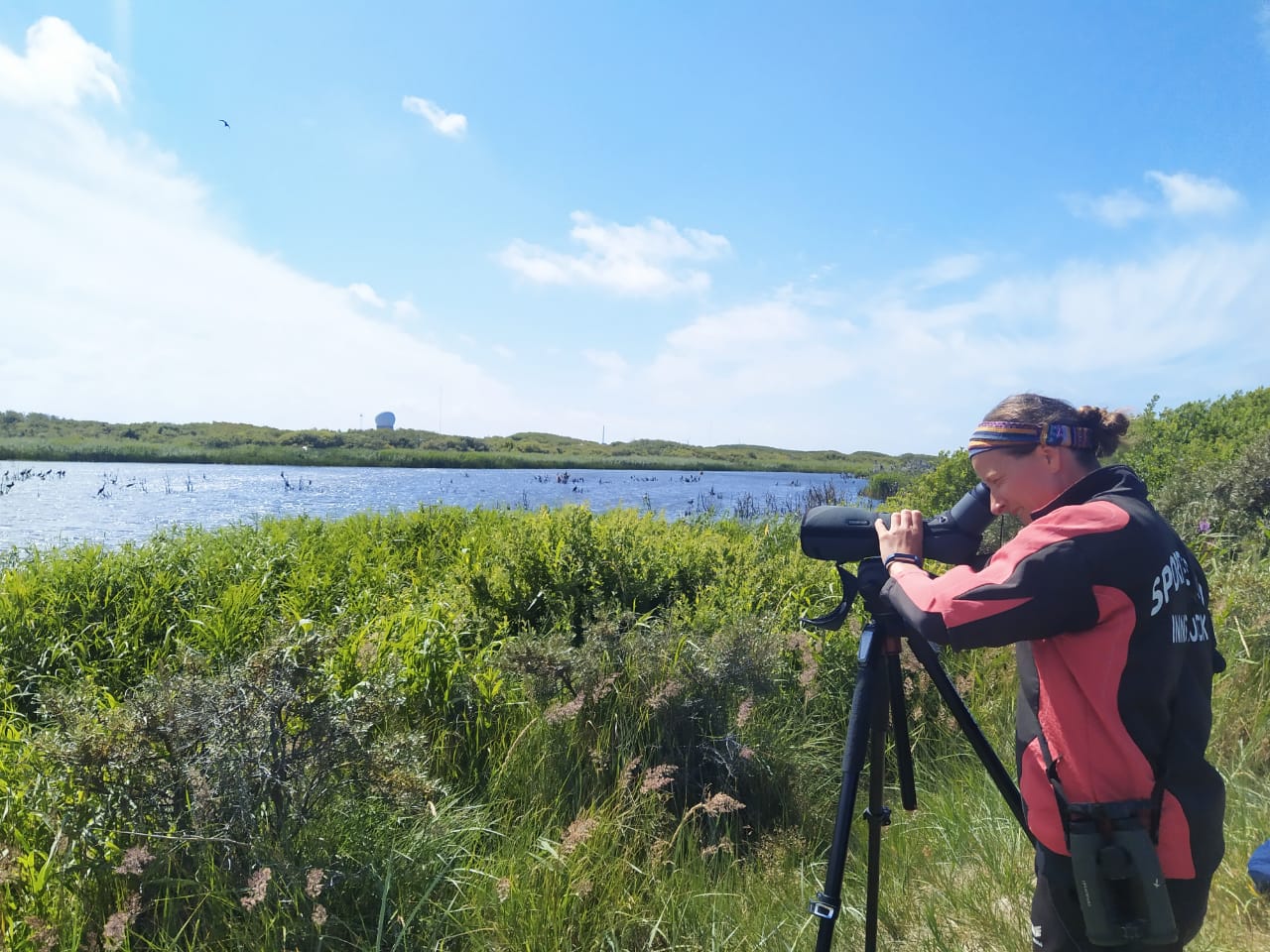
Survey Cormorant Lake
We had our evening meeting together with our guests Mark, Lærke, and Malthe, and later Alice cooked us a lovely dinner.
Cheers!
Max
Ringing at Jerup Strand:
Black-headed gull "Hættemåge" - 1
Common ringed plover "Stor Præstekrave" - 2
Local observations of the day in DOFBasen
People at the Station: Rita DeLucco, Alice Scalzo, Nathan Delmas, Max Laubstein, Simon S. Christiansen,Lisa Vergin, Martina Hillbrand, Lars Bo Jacobsen, and our guests Mark, Malthe and Lærke Desholm
Night active
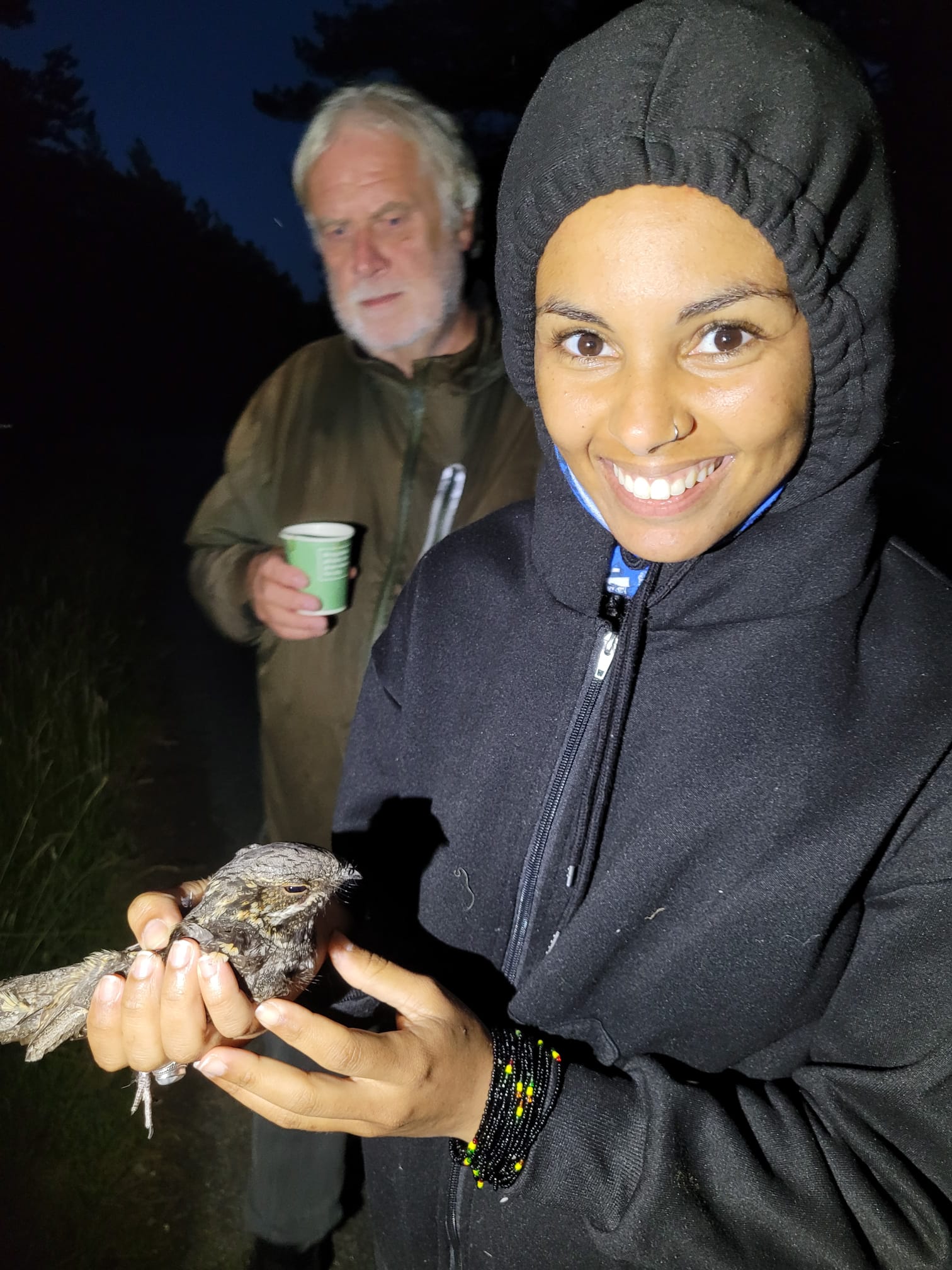 Martina and I on the other hand stayed at the station, so that we could open the nets this morning. Oluf joined us there, and we ringed for a few hours. We got the usual species, many many juvenile Common Whitethroats (Tornsanger), but also our first juvenile Yellowhammer (Gulspurv) of the season. A family also joined us, they were at the ringing yesterday and today, and are really enjoying to see the birds from so close. Don't hesitate to do the same, you can join us there whenever we are ringing !
Martina and I on the other hand stayed at the station, so that we could open the nets this morning. Oluf joined us there, and we ringed for a few hours. We got the usual species, many many juvenile Common Whitethroats (Tornsanger), but also our first juvenile Yellowhammer (Gulspurv) of the season. A family also joined us, they were at the ringing yesterday and today, and are really enjoying to see the birds from so close. Don't hesitate to do the same, you can join us there whenever we are ringing !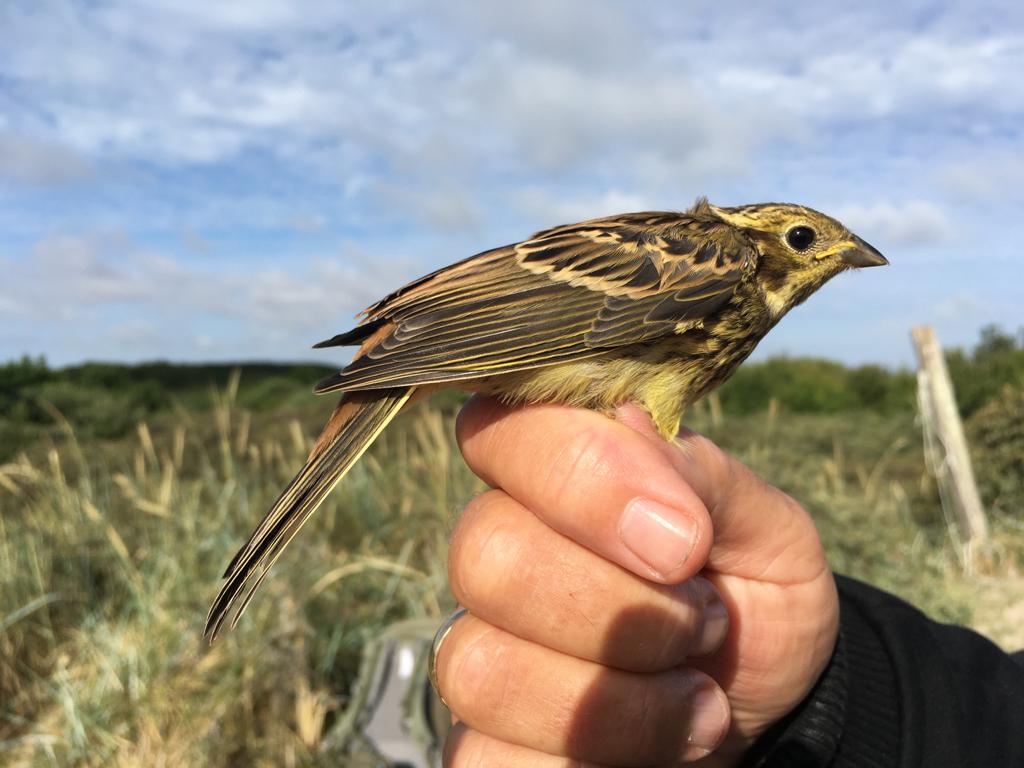 Simon had a meeting with Aarhus university about the radar project and raptor catching. They talked about next autumn and spring. They will test another place to install the radar.
Simon had a meeting with Aarhus university about the radar project and raptor catching. They talked about next autumn and spring. They will test another place to install the radar.